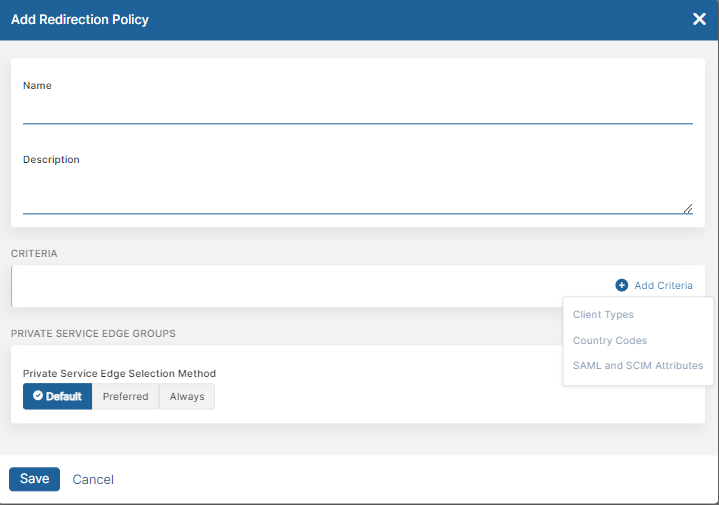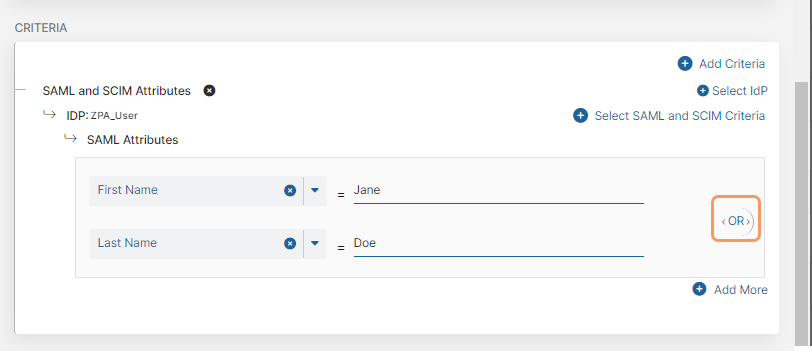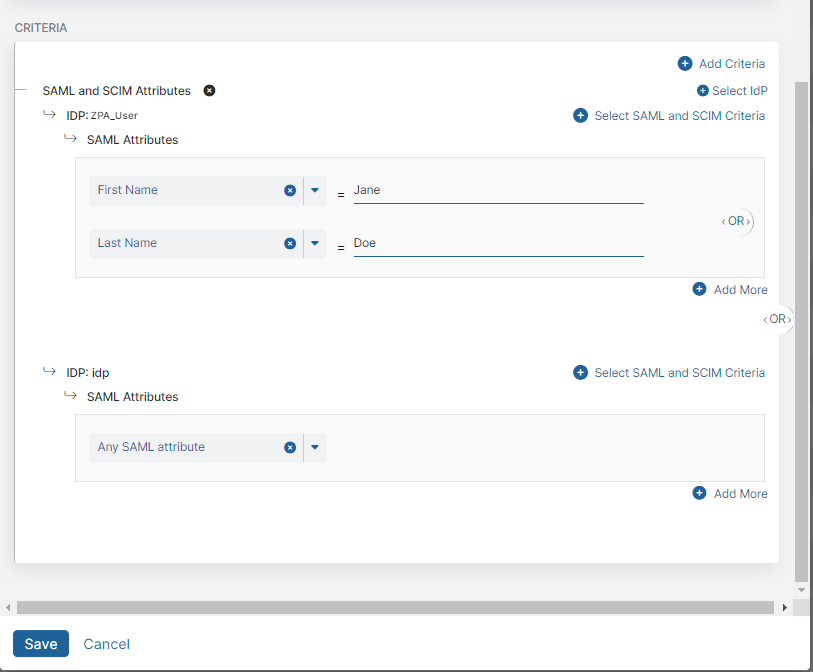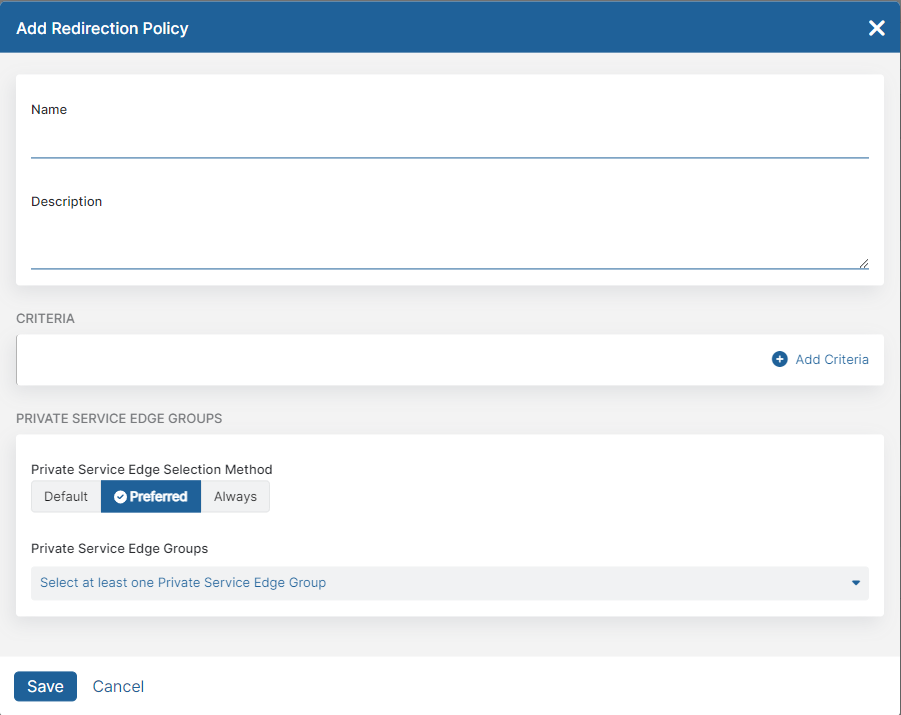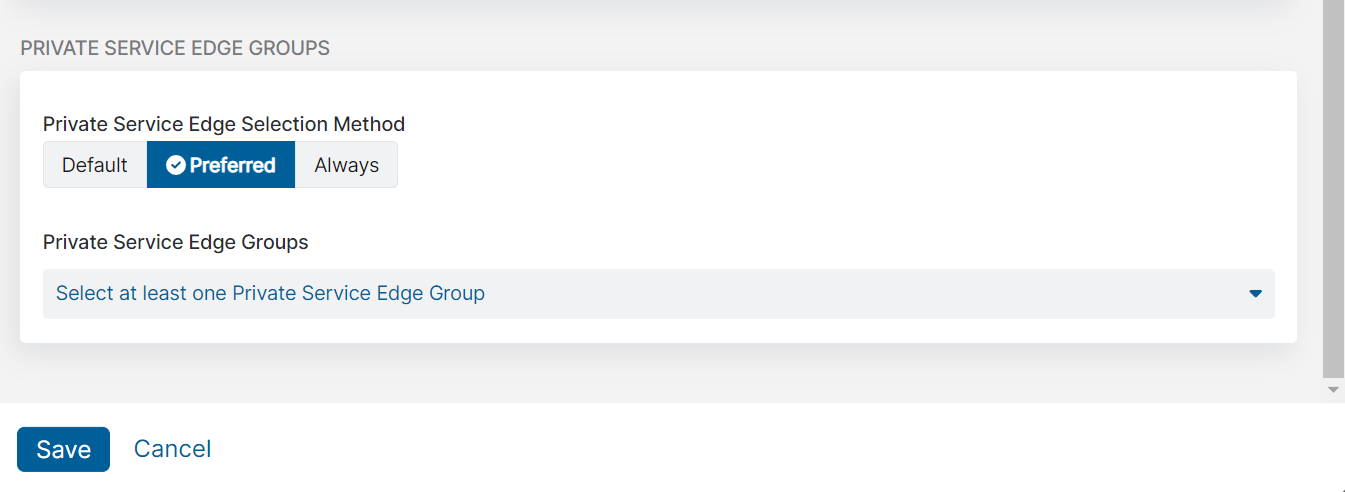Experience Center
Configuring Redirection Policies
You can configure redirection policy rules to prefer Private Service Edges for Private Applications based on country code, client type, and SAML and SCIM criteria. You can specify the method used (Default, Preferred, or Always) for selecting Private Service Edge groups for Private Applications to redirect to.
To configure a redirection policy rule:
- Go to Infrastructure > Private Access > Client Forwarding Policies > Redirection Policy.
- Click Add Rule.
The Add Redirection Policy window appears.
- In the Add Redirection Policy window:
- Name: Enter a redirection policy name. The name cannot contain special characters, with the exception of periods (.), hyphens (-), and underscores ( _ ).
- Description: (Optional) Enter a description.
- For Criteria, click Add Criteria to add any of the available criteria types. The drop-down menu only displays criteria that are not already in use by the rule. You can add up to 10 condition sets.
- Client Types
Choose the client types to which the rule applies. You can search for a specific client type, click Select All to apply all client types, or click Clear Selection to remove all selections. The valid client types are:
You cannot use Branch Connector or Cloud Connector client types if the Private Service Edge Selection Method is Always.
- Branch Connector: To learn more, see About Branch Connectors.
- Client Connector
- Client Connector Partner: To learn more, see About Partner Devices.
- Cloud Connector: To learn more, see About Cloud Connectors.
- Machine Tunnel: To learn more, see About Machine Tunnels.
If you added multiple client types to the policy rule, an OR Boolean operator is used between them.
Rules using the Web Browser or ZIA Service Edge client types additionally can't use posture profiles or trusted networks criteria. The posture profiles or trusted networks criteria only work with Client Connector. Rules using the Branch Connector, Cloud Connector, or Machine Tunnel client types additionally can't use SAML and SCIM attributes criteria.
Close - Country Codes
Choose one or more countries to which the rule applies. You can search for a specific country code, click Select All to apply all country codes, or click Clear Selection to remove all selections. The country codes you've configured appear in the menu. There is no limit to the number you can select.
If you've added multiple country codes to the policy rule, an AND Boolean operator is used between them.
Close - SAML and SCIM Attributes
- Click Select IdP and choose the identity provider (IdP) configuration you want to include in the policy rule. The IdP must be configured for user SSO. To learn more, see Configuring an IdP for Single Sign-On. If you need to include multiple IdPs in the policy rule, click Select IdP again.
- Click Select SAML and SCIM Criteria to add the criteria to which this rule applies:
- SAML Attributes
By default, the policy rule for SAML Attributes is set to Any SAML attribute. Keep this if you want to apply the rule action to any user (i.e., the rule applies to all users, groups, departments, etc.).
Alternatively, choose a specific SAML attribute from the drop-down menu if you want to apply the rule action to specific users, groups, departments, etc.:
- You can search for a specific attribute, select a listed attribute, or click Clear Selection to remove all selected attributes.
- After you make a selection, enter the SAML attribute value (i.e., the users to whom the rule applies) in the text field that appears.
- Click Add More to add multiple attributes, if necessary.
- SCIM User Attributes
Select a specific SCIM user attribute from the drop-down menu to apply the rule action to specific users, groups, departments, etc:
- You can search for a specific attribute, select a listed attribute, or click Clear Selection to remove all selected attributes.
- After you make a selection, enter the SCIM attribute value (i.e., the users to whom the rule applies) in the text field that appears.
- Click Add More to add multiple attributes, if necessary.
- SCIM Group Attributes
Choose a specific SCIM group from the drop-down menu to apply the rule action to a specific group:
- You can search for a specific group, select a listed group, or click Clear Selection to remove all selected groups.
- Click Add More to add multiple groups, if necessary.
These criteria appear under SAML and SCIM Attributes > <IdP Name>, where <IdP Name> is the name of the IdP configuration you selected in step a.
To process SAML and SCIM criteria in a rule, you must enable the SAML Attributes for Policy setting for SAML and the SCIM Attributes and Groups for Policy setting for SCIM when configuring an IdP. To learn more, see Configuring an IdP for Single Sign-On.
If you added multiple attributes or groups to the policy rule, by default, an OR Boolean operator is used between them. For example, if you selected a first name and last name attribute, the policy rule is only applied to users with the specified first name OR last name for that IdP. However, you can toggle this to an AND operator by clicking on it.
If the corresponding IdP setting (SAML Attributes for Policy) is disabled for SAML, but the policy rule has criteria for SAML attributes, the rule is evaluated differently depending on the Boolean operator between the criteria:
- OR: The criteria evaluation is skipped for SAML attributes, but continues to be evaluated for SCIM attributes and SCIM groups.
- AND: This policy rule is not evaluated. You must remove the criteria under SAML Attributes to process the policy rule.
If the corresponding IdP setting (SCIM Attributes and Groups for Policy) is disabled for SCIM, but the policy rule has criteria for SCIM attributes or SCIM groups, the rule is evaluated differently depending on the Boolean operator between the criteria:
- OR: The criteria evaluation is skipped for SCIM attributes and SCIM groups, but continues to be evaluated for SAML attributes.
- AND: This policy rule is not evaluated. You must remove the criteria for SCIM attributes and SCIM groups to process the policy rule.
If you selected multiple IdPs for the policy rule, an OR Boolean operator is used between them by default. For example, you can select one IdP that includes a first name OR last name attribute and another IdP that includes Any SAML Attribute. In this case, the policy rule applies to a user authenticating from the first IdP if they have the specified first name OR last name or it applies to any user authenticating from the second IdP. However, you can toggle this to an AND operator by clicking on it.
If your IdP configuration for SSO includes SAML attributes or SCIM attributes from multiple IdPs, Zscaler recommends that you do not use the AND Boolean operator between policy rules.
Close
The Boolean logic used between Criteria is always displayed. For example, when a user requests access to an application, the policy rule is evaluated to check if an application segment OR its segment group are present AND whether any of the SAML attributes are applicable to the user making the request before it grants or denies access. You can always view the Rule Action and Criteria as well as the applied Boolean logic on the Access Policy page.
- For Private Service Edge Groups:
- For Private Service Edge Selection Method, choose the method used for selecting the Private Service Edge groups for Private Applications to redirect to:
- Default: Use the current Service Edge for Private Applications selection algorithm.
- Preferred: Redirect users to the selected Private Service Edge groups for Private Applications if available, with Public Service Edges for Private Applications as a fallback.
- Always: Always redirect users to the selected Private Service Edge groups for Private Applications if available and prevent the use of Public Service Edges for Private Applications. If there are no active Private Service Edges for Private Applications available in the selected Private Service Edge groups for Private Applications, then users are redirected to a Public Service Edge for Private Applications.
- For Private Service Edge Groups, if Preferred or Always is selected, select one or more Private Service Edge groups from the drop-down menu.
- For Private Service Edge Selection Method, choose the method used for selecting the Private Service Edge groups for Private Applications to redirect to:
- Click Save.

